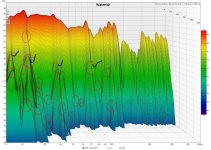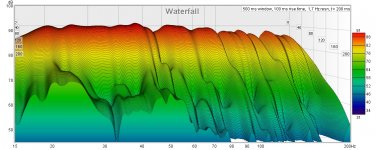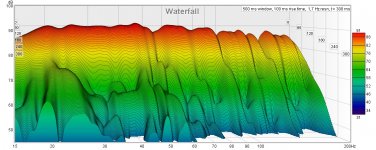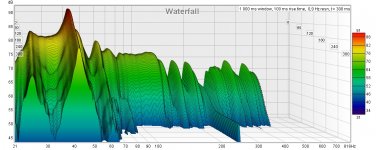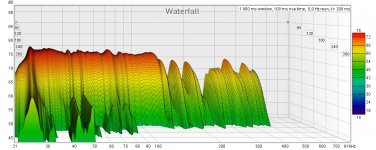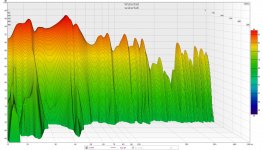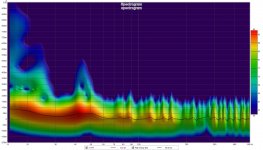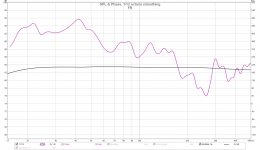Sure, I believe what you said.
I find this very interesting since my knowledge is basic and I'd like to expand it. Hence so many questions.
It's interesting that these anomalies are seen at room mode frequencies.
Could this be more plausible explanation?
I can't imagine how sound could travel outside of the roomand then return and cause this on the graph ... But than again, what do I know.
I find this very interesting since my knowledge is basic and I'd like to expand it. Hence so many questions.
It's interesting that these anomalies are seen at room mode frequencies.
Could this be more plausible explanation?
I can't imagine how sound could travel outside of the roomand then return and cause this on the graph ... But than again, what do I know.
sound could travel outside of the room and then return and cause this on the graph
Replace the underlined word with "can" and you have it!
Hi,
Have 4 subs randomly placed in my room. Through years tried everything up today, but the best sound and spl curve have with 3 pcs (BR) LPF at 50Hz 24LR and fourth at 60Hz (sealed, in counter phase). Main speakers are with HPF at 100Hz 24LR. System is active with two 4-way electronic xo/dsp.
There are only 3 PEQ's on three BR subs. No shelving or other correction applied including delay, except low cuts. Fourth sealed sub is without correction. Subs are in "stereo", found no difference between mono and stereo. IME, lesser number of dsp correction give better sound.
I repeat, have the best bass ever, but wonder, are there theoretical issues with this setting.
My measurements (REW mdat's) are at this moment on other PC what is out of order.
Thanks for reply
Have 4 subs randomly placed in my room. Through years tried everything up today, but the best sound and spl curve have with 3 pcs (BR) LPF at 50Hz 24LR and fourth at 60Hz (sealed, in counter phase). Main speakers are with HPF at 100Hz 24LR. System is active with two 4-way electronic xo/dsp.
There are only 3 PEQ's on three BR subs. No shelving or other correction applied including delay, except low cuts. Fourth sealed sub is without correction. Subs are in "stereo", found no difference between mono and stereo. IME, lesser number of dsp correction give better sound.
I repeat, have the best bass ever, but wonder, are there theoretical issues with this setting.
My measurements (REW mdat's) are at this moment on other PC what is out of order.
Thanks for reply
Is seeing these anomalies at room modes a coincidence?Replace the underlined word with "can" and you have it!
Hi,
Have 4 subs randomly placed in my room. Through years tried everything up today, but the best sound and spl curve have with 3 pcs (BR) LPF at 50Hz 24LR and fourth at 60Hz (sealed, in counter phase). Main speakers are with HPF at 100Hz 24LR. System is active with two 4-way electronic xo/dsp.
My measurements (REW mdat's) are at this moment on other PC what is out of order.
Thanks for reply
Seems to me that you should have a big hole between 60 Hz and 100 Hz.
Again, I do not recommend crossovers to subs.
Without measurements I can't comment further, but if it all works then that's what counts.
Is seeing these anomalies at room modes a coincidence?
Since it has been in every one of your measurements, I doubt that it is a coincidence. It's real, but probably very obscure as to its origin. And since it is meaningless just ignore it.
Seems to me that you should have a big hole between 60 Hz and 100 Hz.
Again, I do not recommend crossovers to subs.
Without measurements I can't comment further, but if it all works then that's what counts.
"but if it all works then that's what counts" this is actually the answer to my post.
Thank's for reply very much.
That's exactly what I'm asking. Since it's on every measurement I thought this might be caused by room modes?Since it has been in every one of your measurements, I doubt that it is a coincidence. It's real, but probably very obscure as to its origin. And since it is meaningless just ignore it.
I know I probably can't eliminate this no matter what is causing this. And I'm not concerned. Just curious how it did get there.
Good enough, it's not a problem so it's not worth worry about. Just remember that it can happen. It's a classic theoretical problem in room acoustics, how two spaces couple each other. A larger room coupled to a smaller (maybe much smaller room) will couple like you see. If this were more pronounced you might hear it as an echo.
I just want to include a few measurements of a large room (about 50 m2) with a double bass array to demonstrate that the DBA configuration will not be particularly more effective against longer bass decay times than any other method of flattening the frequency response. It looks like you will get about 20-25 db drop before 200 ms, which is about the same as I do with a simple PEQ at a mode.Yea, I would say that's likely. It would act just like a free field - outdoors. I have not heard one, but the concept is solid and probably will do what they say - no modes. The question is: Is that what you want to do? Modes are not bad things if they are not high Q. Broaden them with more overlap and the Schroeder frequency falls. The modes then still carry some energy and add to a longer held signal for a better bass perception. Smooth it all out and I'd say that's the best that you can do. In my room there is only a single mode that is evident at about 30 Hz. - the room length mode. It may even be pumping the doors which is why it's a higher Q.
The benefit is that you will get the same response everywhere and at every frequency where the array is effective. In this particular case it's 120 hz. I will not include pictures of the system because this system is not mine, but it's a rectangular room with 16 10" wooferes on both sides of the array.
Included are waterfalls of the DBA at 200 ms and 300 ms and then an example from my rectangular concrete livingroom before and after simple PEQs. I believe this is all evidence we need to support the notion that even a DBA is just another multi-sub configuration, just a predictable one in a rectangular room.
Attachments
Manpole - thanks for this data. I agree with you completely.
Beige - Classic ringing - as I have said at least twice now - has a monotonic decay. When that doesn't happen its not "normal" and something else is involved. Look at the third plot above, at 250 Hz, something other than ringing is going on as this is not a normal decay. Same at 40 and 50 Hz in the fourth one. I can't tell what is going on, but I do know that it is not the ringing down of a mode. If the PEQ is high Q then this could be the ringing of the EQ, but not necessarily as it is very slow.
Beige - Classic ringing - as I have said at least twice now - has a monotonic decay. When that doesn't happen its not "normal" and something else is involved. Look at the third plot above, at 250 Hz, something other than ringing is going on as this is not a normal decay. Same at 40 and 50 Hz in the fourth one. I can't tell what is going on, but I do know that it is not the ringing down of a mode. If the PEQ is high Q then this could be the ringing of the EQ, but not necessarily as it is very slow.
I see what you mean. I always saw these as room modes. If I put room's dimensions in a calculator I get modes at 23 and 45 Hz. But the more I think of your theory the more confused I get. If I make a measurement at the evening and then another one in the morning - the decay times sometimes change while FR remains the same. Everything in the room is intact, mic untouched, gear warmed up, furniture in place ... The only variable I see here is air humidity, pressure and temperature...
Makes me wonder if this is really caused by something outside the room.
However, I did more testing and this time I took more time and tried at least 50 songs I'm familiar with.
Turned out slight vibrations in my back seat were caused by EQ. It was mild (4-5 dB for taming a specific frequency on two subs and 3-4 for boosting on other two) but disabling it improved the sound but made of course an impact on the curve.
Some songs are really good, some have pretty hard bass and some may sound slightly boomy or with too loud low end.
Perhaps a crazy thought: all the songs with assumably high budget mastering sound excellent while some other low-budget songs does not. Listening on a low budget system masks everything so one can't hear so many details?
Here, the plots, no EQ.
Sub1, left corner, vol 24, 180+, HP20/12 LP40/18
Sub2, right corner, vol 25, 180+, HP15/24 LP85/18
Sub3, right sidewall, vol 18, 00+, HP 35/24 LP80/24
Sub4, left sidewall, vol 13, 00+, HP 15/06 LP75/06
Makes me wonder if this is really caused by something outside the room.
However, I did more testing and this time I took more time and tried at least 50 songs I'm familiar with.
Turned out slight vibrations in my back seat were caused by EQ. It was mild (4-5 dB for taming a specific frequency on two subs and 3-4 for boosting on other two) but disabling it improved the sound but made of course an impact on the curve.
Some songs are really good, some have pretty hard bass and some may sound slightly boomy or with too loud low end.
Perhaps a crazy thought: all the songs with assumably high budget mastering sound excellent while some other low-budget songs does not. Listening on a low budget system masks everything so one can't hear so many details?
Here, the plots, no EQ.
Sub1, left corner, vol 24, 180+, HP20/12 LP40/18
Sub2, right corner, vol 25, 180+, HP15/24 LP85/18
Sub3, right sidewall, vol 18, 00+, HP 35/24 LP80/24
Sub4, left sidewall, vol 13, 00+, HP 15/06 LP75/06
Attachments
Last edited:
That the recording industry for ya!Perhaps a crazy thought: all the songs with assumably high budget mastering sound excellent while some other low-budget songs does not. Listening on a low budget system masks everything so one can't hear so many details?
I would agree that:"Listening on a low budget system masks everything so one can't hear so many details"
My privilege. I was dreaming about DBA until I realized that you are correct about how we perceive low frequencies.Manpole - thanks for this data. I agree with you completely.
Now I feel DBA is too costly, complicated and too limiting with regards to acoustical treatments like diffusors, furniture etc. If I can get the ~ same results with 3-4 subs, why go through the headache?
Quick question; what does it take for you to consider the bass issue a solved problem in a room? Aka the point where you feel there's nothing to gain by going further?
If I may dig deeper into the ringing thingIf the PEQ is high Q then this could be the ringing of the EQ, but not necessarily as it is very slow.
- Home
- Loudspeakers
- Subwoofers
- Multiple Small Subs - Geddes Approach
